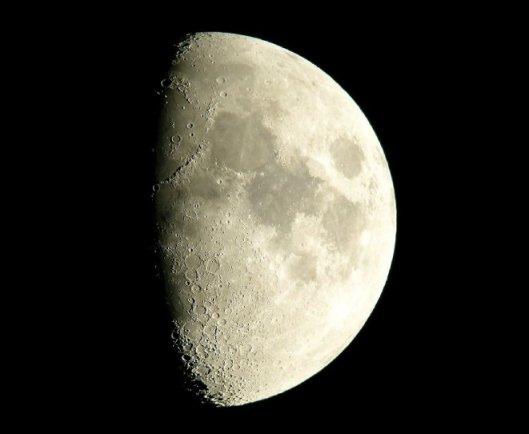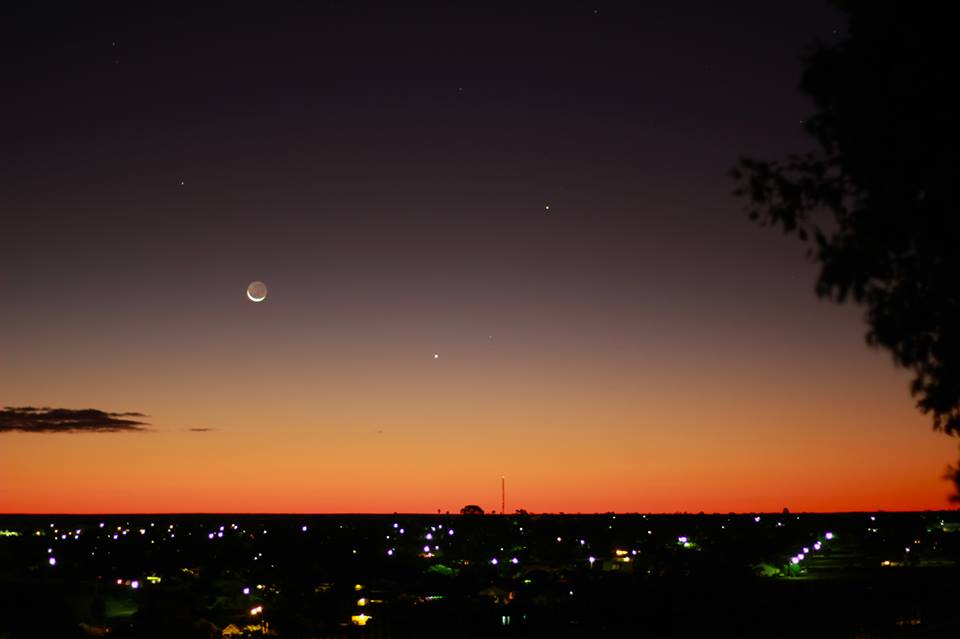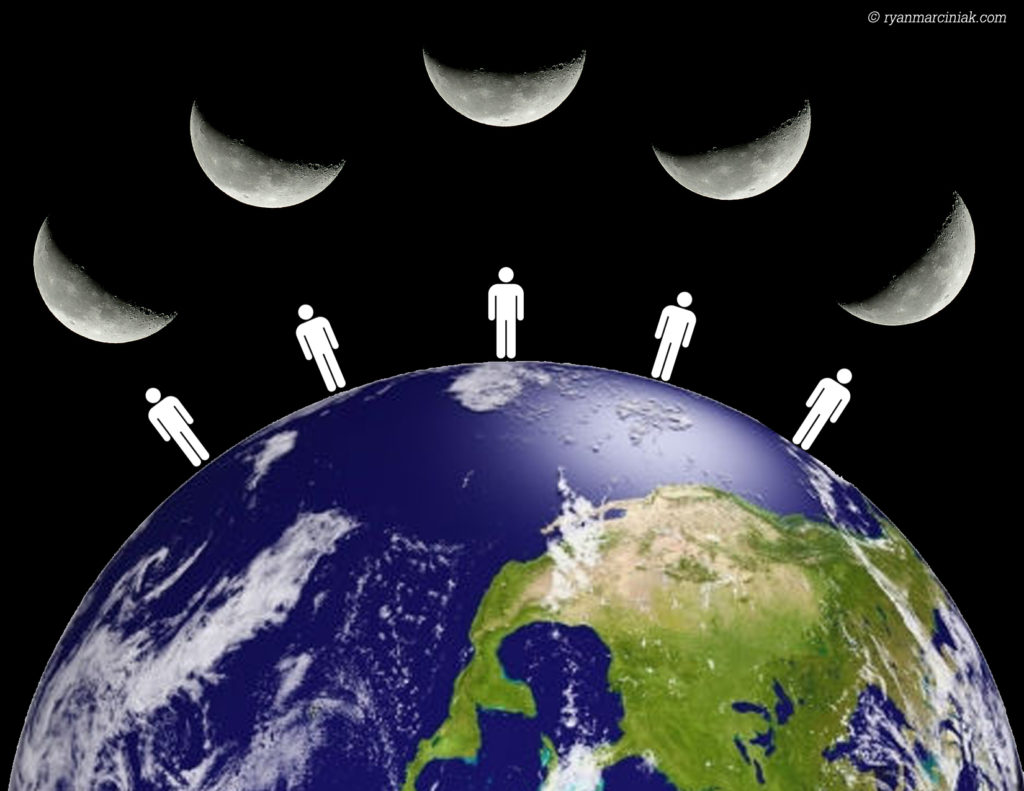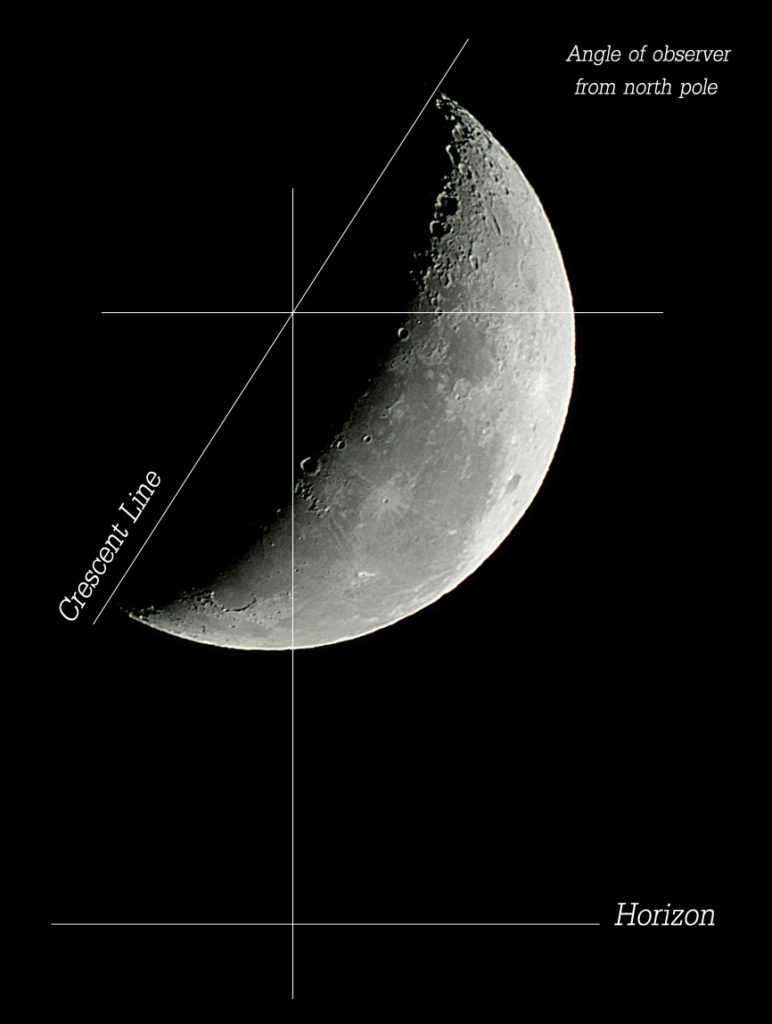I was out on a sunny day a few weeks ago waiting for a bus, and as per usual I have my head up in space (I would say up in the clouds but that is too low for me). I noticed the Moon up in the sky, just past first quarter, and I was thinking about the angle of the illuminated side and how it related to some of the positions of the Earth and Sun in space. I wondered what information we could gather from the way it looked. It led me to this ‘illuminating’ post.

I realized that if you draw a line from the top of the crescent to the bottom of it, that line would be perpendicular to a line from the Sun to the Moon and consequently from the Sun to the Earth. But why was this line angled (as per the drawing below)?

For one, I noticed that this imaginary line would point south, which instantly became a great navigation tool. Go try it for yourself, most of the time it will very accurately point south. I say most of the time because it’s not as accurate when the Moon is close to the horizon.
This is true for those in the northern hemisphere, but what about for the rest of the world?


I looked at some photos of the Moon taken by photographers in the southern hemisphere and along the equator (isn’t the internet great?), and the findings were quite interesting. Both the position in the sky and the angle of the Moon changed.
The imaginary line from one side of the crescent to the other was pointing north when viewed in the southern hemisphere, and when at the equator the line was straight. This makes sense, since it seems one side points north and the other south. So the trick for southern observers is that you can use the Moon to find north and get your bearings the same way as I do on the other side of the planet.

Then a true realization hit me. For an observer standing on the Earth, the apparent angle of the Moon’s crescent could be used to give a rough estimate of the observer’s latitude! All you have to do is make a line through the Moon perpendicular to the horizon and a line from one side of the crescent to the other. The angle between these two lines will give you you’re rough position latitudinally on the Earth.

So there you have it. Not only can you navigate with the Moon, you can use it to figure out where you are on the Earth. Astronomically speaking, the assumptions you make are that the Earth is round and that the Sun is infinitely far away so it’s light falls parallel to the Earth and Moon. The Earth is round for sure, but the Sun isn’t infinitely far away, though it is a safe assumption to make since the Sun is so large and distant.
It’s amazing how an understanding of astronomy and a bit of math can combine to make some pretty cool navigational tools, and tell us where we are on the Earth. This is true science, using what you see to make predictions about your world.

we know that the lit part of the moon will show where the sun is. and we know that sun’s position varies between -23,5 to 23,5 degree from equator. so there will be some unique cases, say when the sun is in its southest positions people in equator will see the lit part of the moon will point not directly down but rather tilted to south. 6 months later, it will be tilted to north. your picture then not 100% accurate, because it seems only valid in equinoxes of the year. am i right?
my question is, can we still use this navigation technique in these cases?
Good Question, but it’s not quite right. The Earth and Moon both have roughly the same orbital plane (The Moon has a 5 degree tilt). The apparent variation in the Sun’s position is due to the tilt of the Earth, but this makes no difference to the Moon. The variation occurs because the Earth is spinning. If you look at the image here, the orbital plane is the horizontal line through the Earth and Moon. If you pick a point on Earth and spin the Earth along it’s tilted axis, that point you chose will move up and down horizontally relative to the orbital plane, every night. So it actually depends on what time of day or night you are looking at the Moon, not what time of year.
This also means the technique will vary daily, and will be most accurate when the crescent moon lines up perpendicular to the Earth’s axial tilt. So it is a very rough estimate to determine where you are on the Earth, but it will almost always be accurate when you use the crescent angle to find North or South.
interesting. two years ago i moved near equator and never payed attention to this until a coleague from work told me about the “shape” of the moon. today i could clearly see a thin crescent under a dark circle.
Hi I just read your explanation. Sorry I’m not that clever but all my life living in london I saw the moon one way eg. When in a Crescent shaped. now it looks reversed. I’m I going mad!!
One observation lately, right? But you are not mad. The mnemonic, dating from at least the ancient Romans, is that the moon is “deceptive” [I remember it as “deceptively strong”]. When the crescent is “D” shaped, then the moon is waxing towards a full moon. When the “D” is backwards, then the moon is waning.
I’m not new to watching the moon and stars. I have a family member who thinks the moon is “cartwheeling” to put it in simple terms. I don’t see this. He says it can raise waxing and set waning, like you just took a plain from New York to Australia. Why would he think this. He keeps sending me time stamped photos to try and prove his point. Help me understand what he sees, please. Thank you for your time
It can be difficult to understand the motions of the Earth, Moon, and Sun from our perspective. After all, we are spinning daily along with the Earth.
It seems your family member may see the crescent Moon point one way when it rises ( , and the other when it sets ), but the shift is not in the Moon, it is in the observer’s perspective. The Moon itself hasn’t changed. The viewing angle of the Moon has.The Moon takes 29.5 days to orbit the Sun completely. Night by night, the apparent movement of the Moon comes from the spinning of the Earth.
The best question to ask may be: If you see the Moon waning at dusk and waxing at dawn over a single night, does that mean it’s full at midnight? The answer is of course no, and so the phase of the Moon stays visually the same over the course of an evening.
Can you express the crescent angle as a function of time, observer location, and Moon almanac values of RA and declination?
I am working on producing a practically accurate Moon image for a PDF, PostScript, or SVG format given the usual values from, say, Perl module Astro::Montenbruck. I have the image working great for observer location and fraction of illumination and would love to also apply the proper crescent angle.
See my current work (in the Raku language) at .
It seems plausible that this would work, though I haven’t tried such a derivation myself. There may be a bit of trouble with a Gibbous Moon, but let me know if it works for you!